Kobukusa and Mandala Part 2
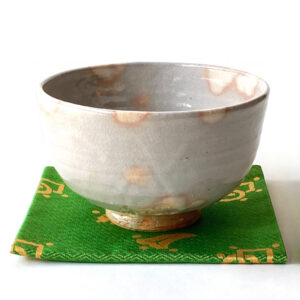
In Chanoyu, when serving tea to a guest, the cha-wan, 茶碗, tea-bowl, may be placed on a ko-buku-sa, 古帛紗, old-cloth-gauze. The kobukusa is also used to display a revered object. There are countless types of fabrics, including treasured cloths from the past and also of foreign origin. The type of fabric reveals the choice and taste of the owner. Of the several sizes of kobukusa, the standard measures 4 x 4.2 sun kujira-jaku.The diagonally measurement is 5.8 sun kujira-jaku. The number 5 may represent the Go-rin, 五輪, Five-rings, principles, and the Go-gyō, 五行, Five-transitions, and the number 8, hachi, 八, is symbolic of Infinity in Space. When wearing kimono, the kobukusa, together with a fuku-sa, 帛紗, cloth-gauze, and kai-shi, 懐紙, heart-paper, are kept in the front folding of the kimono, futokoro, 懐, it is called a kai-chū ko-buku-sa, 懐中古帛紗, heart-middle old-cloth-gauze.
Some fabrics are plain silk weave with a satin pattern, while others are colorful with elaborate designs, and many with gold threads and gold leaf. Treasured fabrics have been used as decoration on Buddhist altars for millennia, and as the Tea Ceremony has origins in Buddhist temple procedures and traditions, the gorgeous fabrics of Buddhism were adopted into Chanoyu.
In Chanoyu, there are many types of fabrics. The fabrics preferred for Tea utensils in order of formality are don-su, 緞子, damask-of, kin-ran, 金襴, gold-brocade, kan-tō, 間道, interval-way, and nishiki, 錦, multi-color brocade.
An essential aspect of Buddhism and its teachings are manifest in pictures of and idealized paradise filled with a multitude of deities that are called mandala. The mandala is a symbolic map from the human perspective of the universe and pathway to liberation representing the cosmos metaphysically or symbolically. The mandala has its origins in India, with influences from Tibet, China, Korea, and Japan. The Sanskrit word ‘mandala’ means ‘circle’.
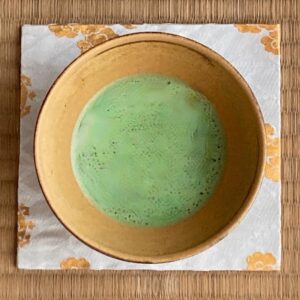
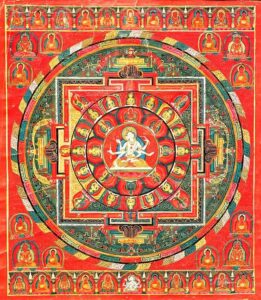
Left: cha-wan, 茶碗, tea-bowl, ceramic bowl with yellow glaze supported on a ko-buku-sa, 古帛紗, old-cloth-gauze. Right: ‘Ushnishavijaya Mandala’ with circle motif, Tibet, circa 1500.
The pictured cha-wan, 茶碗, tea-bowl, is a ceramic Ten-moku-gata, 天目型, Heaven-eye-shape, with wheat color glaze, Kikkō yaki, 吉向焼, Good luck-beyond-fired; diam. 4.4 x 2.3 sun kane-jaku. The chawan was made in 1963 for the 700th anniversary of the Shin-ran, 親鸞, Parent-mythic bird, [1173-1263] founder of the Jō-do Shin-shū, 浄土真宗, Pure-land New-sect, given at Higashi-Hon-gan-ji, 東本願寺, East-True-vow-temple, Kyōto. ko-buku-sa, 古帛紗, old-cloth-gauze, white silk fabric with lightning motif, with gold leaf designs of Buddhist hō–rin, 法輪, law-wheel.
The pictured above Ushnishavijaya Mandala, Victorious Crown Goddess Mandala, features in the central circle, the ‘White Tara’ who is the Buddhist deity of long life, surrounded by her retinue. The outer square represents a heavenly palace according to sacred architectural principles. It is significant that the kobukusa, symbolic of the mandala, supports a chawan that is the circle of the mandala.
Perhaps the most important and among the earliest mandala in Japan introducing and teaching Buddhism, are the Ryō-kai Man-da-ra, 両界曼荼羅, Both-worlds Wide-weed-spread.
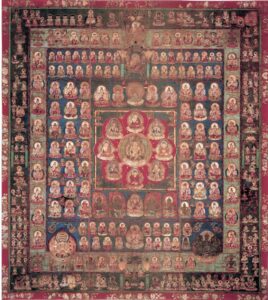
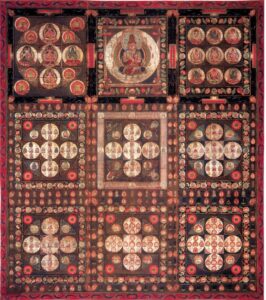
Dai-nichi Nyo-rai, 大日如来, Great-sun Like-become, is the principal deity in both Mandara. The Ryōkai Mandara is two sides of the concepts, and they are joined at the west side of each mandala, just as the kobukusa fabric is folded in half. The Sanskrit word ‘mandala’ in Japanese is read mandara.
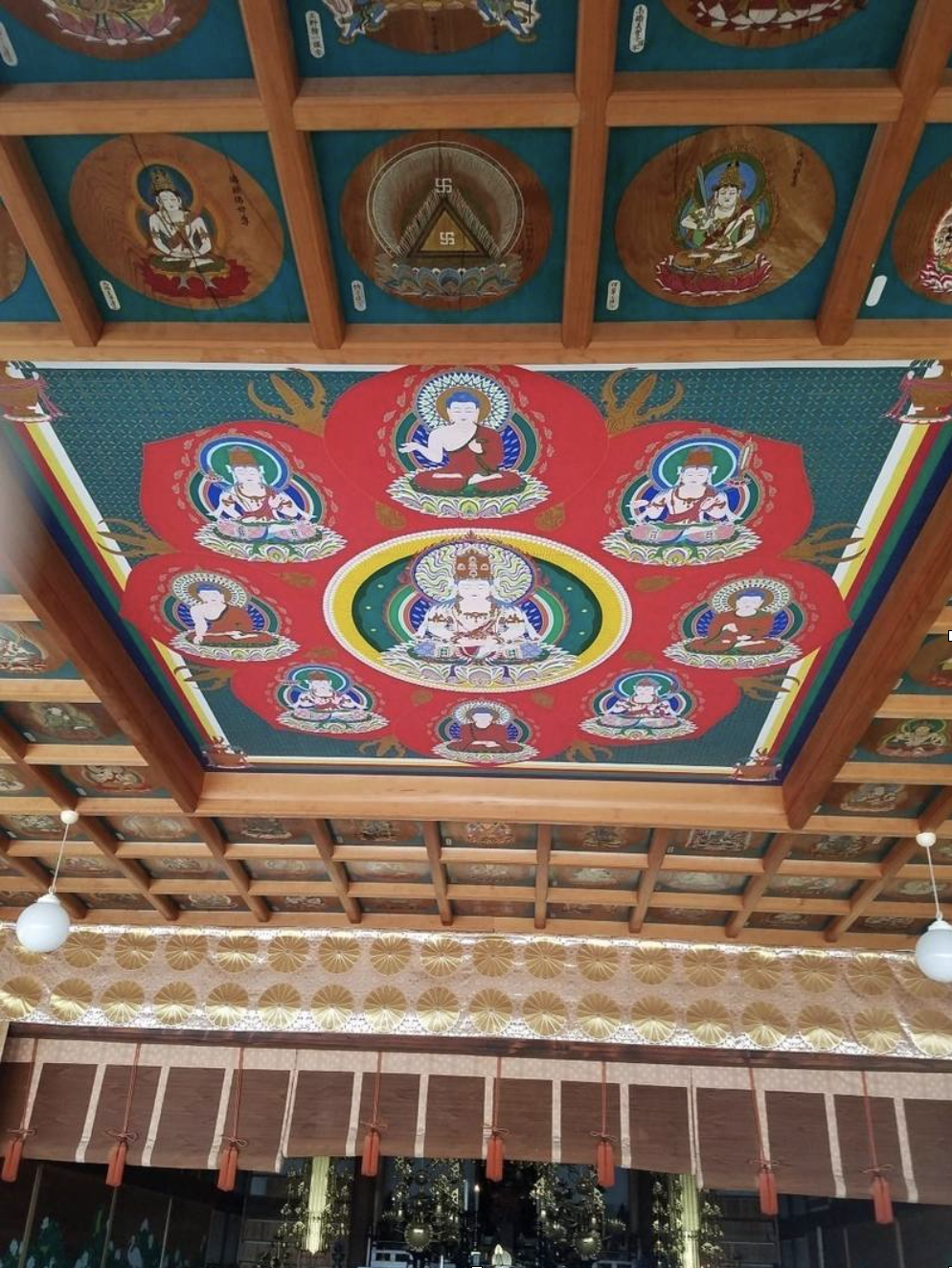
The Taizōkai Mandara, 胎蔵界曼荼羅, Womb-keep-world Wide-weed-spread, may be identified with the ceiling, ten-jō, 天井, heaven-well, of the yo-jō-han cha-shitsu, 四畳半茶室, four-mat-half tea-room, and the Kon-gō-kai Man-da-ra, 金剛界曼荼羅, Gold-strength-world Wide-weed-spread, may be identified with the tatami on the floor of the yojōhan chashitsu.
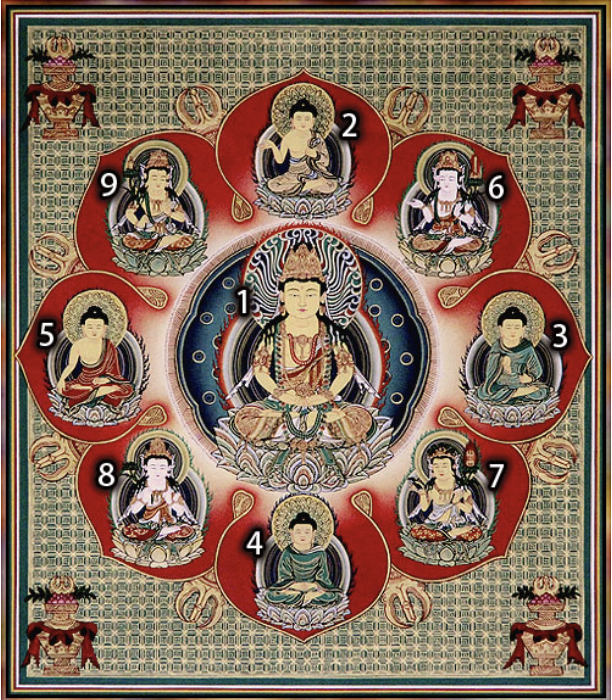
1 Dai-nichi Nyo-rai, 大日如来, Great-sun Like-become
2 Hō-tō Nyo-rai, 宝幢如来, Treasure-flag Like-become
3 Kai-fu-ke-ō Nyo-rai, 開敷華王如来, Open-spread-flower-kingLike-become
4 Mu-ryō-ju Nyo-rai, 無量寿如来, No-measure-life Like-become
5 Ten-ku-rai-on Nyo-rai, 天鼓雷音如来, Heaven-drum-thunder- sound Like-become
6 Fu-gen Bo-satsu, 普賢菩薩, Wide-knowledge Grass-buddha
7 Mon-ju Bo-satsu, 文殊菩薩, Literary-exceptional Grass-buddha
8 Kan-ji-zai Bo-satsu, 観自在菩薩, See-self-exist Grass-buddha
9 Mi-roku Bo-satsu, 弥勒菩薩, Increase-reign Grass-buddha
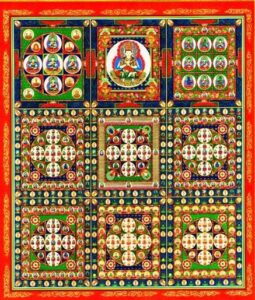
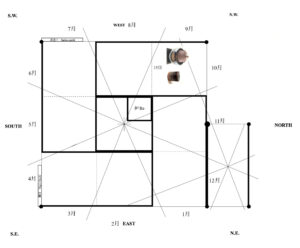

In the center of the top row of the Kon-gō-kai Man-da-ra, 金剛界曼荼羅, Gold-strength-world Wide-weed-spread (in the above picture on the left), which is identified with the west, is the lone figure of Dainichi. The is the same location as the teishu in the yojōhan chashitsu. Center: diagram of yo-jō-han, 四畳半, four-mat-half, showing fu-ro, 風炉, wind-hearth, and mizu-sashi, 水指, water-indicate. Right: detail of the Kongōkai Mandara, square with the principle image of Dainichi.
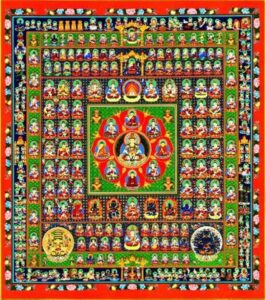
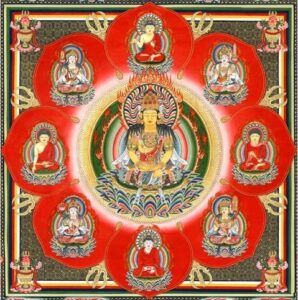
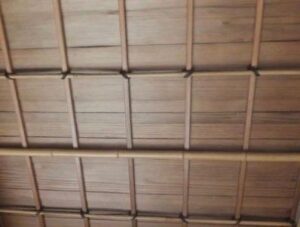
Left: Tai-zō-kai Man-da-ra, 胎蔵界曼荼羅, Womb-keep-world Wide-weed-spread. Right: image of Dai-nichi Nyo-rai, 大日如来, Great-sun Like-become, from the central Chū-dai-hachi-yō-in, 中台八葉院, Middle-support-eight-leaf-temple, in the central element of the Tai-zō-kai Man-da-ra, 胎蔵界曼荼羅, Womb-keep-world Wide-weed-spread. Dainichi is located in the center of four Nyorai who are located above, below, and at each side, whereas the four Bosatsu are in the corners. The word ‘leaf’ refers to the idealized eight petals of a lotus flower. Right: detail of the ceiling of a yojōhan chashitsu.
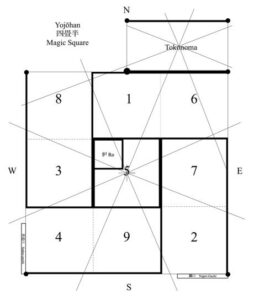

Diagram of the yo-jō-han cha-shitsu, 四畳半, four-mat-half tea-room, with the numbers of the Magic Square superimposed upon it. The five Yō, 陽, positive, penetrative, odd numbers are in a cross, and the four In, 陰, negative, receptive, even numbers are located in the corners. Even numbers can be divided in half equally to get whole numbers. Odd numbers divided in half create fractions.
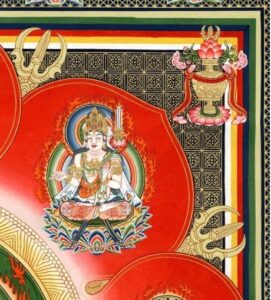
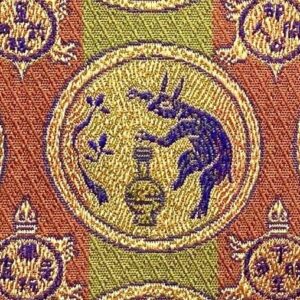
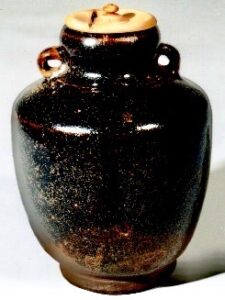
Left: detail of Dainichi center of Taizōkai Mandara showing the proximity of the Bosatsu (pictured is an image of Fu-gen Bo-satsu, 普賢菩薩, Universal-wisdom Grass-buddha), and one of the four hō-byō, 宝瓶, treasure-bottle vessels of sacred water, and adorned with flowers in each corner.
Middle: detail from a fabric inspired by the ancient Tai-ma Mandara, 当麻曼荼羅, Right-hemp Wide-weed-spread; the form of the usu, 臼, mortar, bottle containing the elixir of immortality, is similar to the urns in the Taizōkai Mandara.
Right: ceramic cha-ire, 茶入, tea-receptacle, mimi-tsuki, 耳付き, ears-attached, with mottled brown glaze, Se-to-yaki, 瀬戸焼, Rapids-door-fired; H. 3.2 sun kane-jaku. The chaire is a container for powdered koi-cha, 濃茶, thick-tea, which is symbolic of various elixirs of life: Vedic soma, Hindu amrita, Buddhist kan-ro, 甘露, sweet-dew, Taoist jin-dan, 金丹, gold-elixir (cinnabar), etc. The vessel in the mandara is one of the eight sacred symbols in Buddhism.

The central square of the Taizōkai Mandara with Dainichi in the center, surrounded by eight Buddhist deities. In each of the four corners is a hō-byō, 宝瓶, treasure-bottle vessels of sacred water, and adorned with flowers. In the early history of Tea in Japan, individual bowls of tea were made for each guest. In formal settings, the tea was prepared in a Ten-moku ja-wan, 天目茶碗, Heaven-eye tea-bowl. Tea was associated with Buddhism, and tea was, and is, an important offering to deities, and the Tenmoku tea bowls were used in the rites.
Chaire are relatively small, and have a limited capacity; some large chaire can hold enough matcha to serve ten or so individuals. It is apparent that a large number of people in temples requires several tea containers. Of course, it depends on the amount of tea powder for an individual bowl of tea. Perhaps, in theory, each recipient was served tea in individual bowls, each participant may have had an individual container of tea. This would be in accord with the four hōbyō depicted in the corners on the court of Dainichi.
The four hōbyō may have connections with the four corners of the magic square. The numbers in the corners are even numbers: 2, 4, 6, 8, which are earthly numbers, and manifest the aspect of In, 陰, negative, receptive. Each can be equally divided in half resulting in whole numbers. An implication is that the tea itself can be divided and shared. In the above picture of Dainichi’s court, there is a Vajra/Kongō with its curved talons emerging from each hōbyō. The Vajra can surely be likened to the cha-sen, 茶筅, tea-whisk, that would help create the tea.
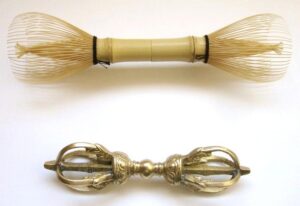
The hōbyō is one the Buddhist emblems of good fortune, hachi-ki-sshō, 八吉祥, eight-joy-omen. The hōbyō symbolizes the teachings of Buddhism, which never runs out, no matter how many teachings are passed on. It is associated with health, longevity, and symbolizes wealth, prosperity, wisdom, and space.
In Dainichi’s court, the four hōbyō are in close proximity to the four Bosatsu. This may suggest that the Bosatsu are in possession of the hōbyō, and distribute the life-giving elixir on behalf of the four Nyorai. Perhaps even serving tea to the Nyorai. In the full Cha-ji, 茶事, Tea-matter, a single bowl of koi-cha, 濃茶, thick-tea is shared by the four guests. When distributing the relics of the cremated body of the Buddha, they were given to four levels of deities. Afterwards, the ashes were divided into eight parts, and given to eight devout kings. In a Chaji, each of the four guests has two bowls of usucha. This suggests the possible connection between the eight portions of the ashes of Buddha, and eight bowls of usucha.
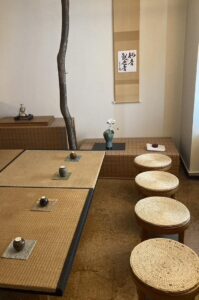
Garandō Tearoom set with an imagined arrangement of four chai-re, 茶入, tea-receptacle, placed on individual ko-buku-sa, 古帛紗, old-cloth-gauze.
Pictured in the tokonoma is a hanging scroll with a shiki-shi, 色紙, color-paper, with calligraphy, Myō-on Kan-ze-on,妙音観世音, Wondrous-sound See-world-sound, written by an un-named Buddhist monk, San-jū-san-gen-dō, 三十三間堂, Three-ten-three-bay-hall, Ren-ge-ō-in, 蓮華王院, Lotus-flower-king-temple, Kyō-to, 京都, Capital-city; 9 x 8 sun kane-jaku (ratio is 8.888 to infinity). The shikishi is temporarily displayed on a shiki-shi-kake, 色紙掛け, color-paper-hang.
Also in the tokonoma is a hana-ire, 花入, flower-receptacle, Korean celadon vase on a black lacquered usu-ita, 薄板, thin-board, and, a kō-go, 香合, incense-gather, impressed-lacquer covered container on a pack of kami kama-shiki, 紙釜敷, paper kettle-spread.
At the end of certain Tea presentations, when the guests look at a chaire, the chaire is placed on the guest’s own kobukusa, rather than with a kobukusa offered by the host, tei-shu, 亭主, house-master.
Features of Kobukusa
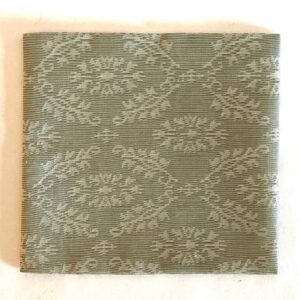
Ko-buku-sa, 古帛紗, old-cloth-gauze. The fabric was woven by Taka-da Yoshi-o, 高田義男, High-field Righteousness-male, artisan for the Imperial court. The kobukusa was fabricated by Ki-ta-gawa Hei-rō, 喜多川平朗, Joy-multi Peace-clear, a Nin-gen Koku-hō, 人間国宝, Person-interval Country-treasure, Living National Treasure of Japan, and an artisan for the Imperial court. The kobukusa is identified as yū-shoku ori-mono, 有職織物, have-work weave-thing, referring to its employment by the Imperial court of Japan. The threads are rather stiff, and the fabric has an open weave that makes it shear like ro, 絽, silk gauze, for light summer clothing, and sha, 紗, gauze. The general term for woven fabrics is ori-mono, 織物, weave-thing; kire-ji, 裂地, split-ground, in English means fabrics, cloths, etc.
The kobukusa was supplied by Tatsu-mura Bi-jutsu, 龍村美術, Dragon-town Beauty-way, Kyōto. The weaver and the kobukusa maker are acknowledged artisans that create fabric utensils for the three Sen families.
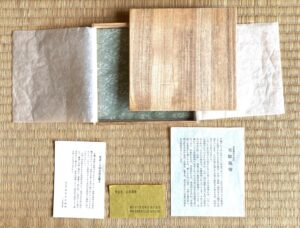
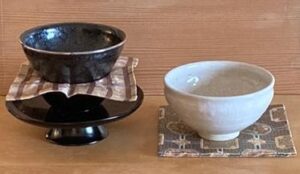
Left: yu-teki ten-moku ja-wan, 油滴天目, oil-drip heaven-eye tea-bowl, by Oke-tani Tei-ichi, 桶谷定一, Bucket-valley Establish-one, Kyō-yaki, 京焼, Capital-fired. Ko-buku-sa, 古帛紗, old-cloth-gauze, ‘Ama-ryūKan–tō’, 雨龍間道, Rain-dragon Interval-way, Nishi-jin-ori, 西陣織, West-camp-weave, Kyōto. Dai, 台, support, black-lacquered turned wood three part stand. Right: white ceramic cha-wan, 茶碗, tea-bowl, in the form of Ten-moku, 天目, Heaven-eye, by Kasa-hara-yaki, 笠原焼, Umbrella-field-fired, Shi-no, 志野, Aspire-field. Supported on a ko-buku-sa, 古帛紗, old-cloth-gauze.
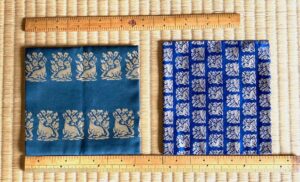
According to Kita-mura Toku-sai, 北村徳斎, North-town Virtue-abstain, a leading Japanese supplier of fabrics and fabric utensils for Chanoyu, the established size of the kobukusa is 4 x 4.2 sun kujira-jaku.
The kobukusa is not square, which may prompt questions as to why. The fukusa as well, is not square. The original fabric for a fukusa measures 1 x 2 shaku kane-jaku. The fabric is folded in half, and hemmed on three sides thus creating a near-square rectangle. The kobukusa is not simply one-quarter of the size of the fukusa. It appears that when a kobukusa is placed on tatami, the height of the kobukusa is ten tatami me, and its width is eleven tatami me. These measurements may be coincidental. The intention was, and is, to make the kobukusa so that it is related to tatami, which is a product created using the kujira-jaku. It should be remembered that tatami is also a product of weaving.
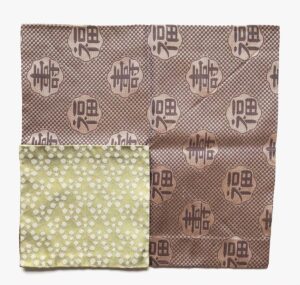
The kai-chū ko-buku-sa, 懐中古帛紗, heart-middle old-cloth-gauze, is about one-quarter the size of the Yabu no uchi, 薮の内, Thicket’s within, school of Tea, dashi-bukusa, 出帛紗, out-cloth-gauze. This comparison may be relevant, as the Yabunouchi school served the luxury-prone aristocracy, whereas, Urasenke school serves the more modest merchant. The kaichū kobukusa was adapted from the earlier, larger fukusa which became known as a dashibukusa.
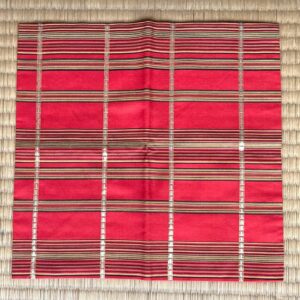
The fabric pictured above was inspired by ‘wa-ran-da mo-men’, 和蘭陀木綿, harmony-orchid-steep tree-cotton, which believed to be like one of the large cotton plaid fabrics imported from Southeast Asia through the Dutch trade after the mid-Edo period.
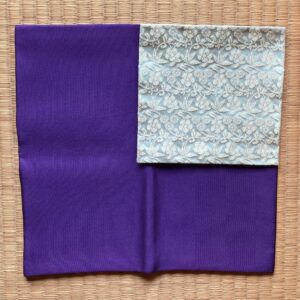
It is recorded that Sō-on, 宗恩, Sect-mercy, Rikyū’s second wife, felt that the luxurious fukusa was not in keeping with Buddhist austerity, so that she created a fukusa with plain fabric, mu-ji, 無地, no-ground.
Rikyū’s fukusa measurements 9 x 9.5 sun kane-jaku – 7.2 x 7.84 sun kujira-jaku: relative to tatami: 18 x 19 tatami me. This fukusa when folded in half diagonally has a length of 13.08 sun kane-jaku. This number may not appear to have any obvious connections, however, in Buddhism, there are the Jū-san-butsu, 十三仏, Ten-three-Buddhas, who oversee particular funeral rite periods. The number 8 is symbolic of Infinity in Space. The number 13 is identified as a center surrounded by 12, such as the 12 animal signs of the Asian zodiac, a clock face with 12 numbers, etc.
The kobukusa is a microcosm of aspects of the yo-jō-han, 四畳半, four-mat-half, tea-room which itself is a microcosm of a mandala, Japanese mandara. Perhaps the most important are the Ryō-kai man-da-ra, 両界曼荼羅, Both-worlds Wide-weed-spread. The pair are the Tai-zō-kai Man-da-ra, 胎蔵界曼荼羅, Womb-keep-world Wide-weed-spread, and the Kon-gō-kai Man-da-ra, 金剛界曼荼羅, Gold-strength-world Wide-weed-spread. Dainichi Nyorai is the principal deity in both Mandara.
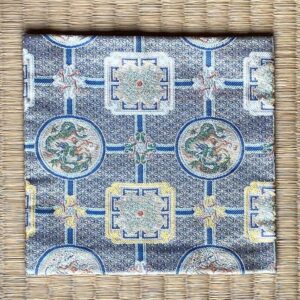
The Kongōkai mandara may be identified with the tatami-covered floor of the yo-jō-han, the Taizōkai mandara may be likened to the ceiling of the yojōhan. To appreciate and comprehend, is to understand the nature of the magic square and the yojōhan, and its possible identification with the mandara, it is important to remember that there are countless variations of mandala. Parallels may be drawn between mandara designs and fabric designs for various Tea utensils, such as a kobukusa, and shifuku for chaire, chawan, chashaku, etc.
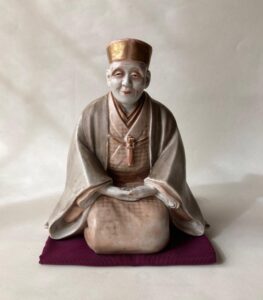
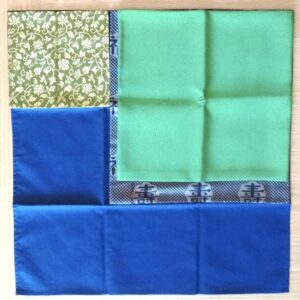
Comparison of various fabric utensils used in Chanoyu and Buddhism. Upper left: green silk ko-buku-sa, 古帛紗, old-cloth-gauze. Upper right: green silk fuku-sa, 帛紗, cloth-gauze, overlaying violet dashibuku-sa, 出帛紗, out cloth-gauze. Blue cotton ha-ttan, 鉢単, bowl-single, Buddhist meal placemat. The hattan is a square mandala comprised of nine squares, and is an approximation of the nine-square Kongōkai Mandara.
Each one of the Ryōkai Mandara is based on the concept of ‘nine’, one surrounded by eight. The Kongōkai and Taizokai Mandara, are joined at the side identified as west. Together, the mandara may be seen as rectangle folded in half. The nine squares of the Kongōkai and the nine petals of the lotus may be united and evoke the number eighteen, jū-hachi, 十八, ten-eight. The Kanji, 十 and八, may be written together to form the Kanji, ki, 木, tree, which a symbol for ‘life’. Ki is a homonym of ki, 生, life.
Folding the fukusa is called sabaki, 捌き, handling, and examining the fukusa is also called sabaki, but the Kanji is different, 裁き, examine. There are several ways to fold and examine the fukusa. When preparing to purify a Japanese Tea utensil, the fukusa is folded along the diagonal, which may be deemed sō, 草, grass, informal, and gyō, 行, transitional, semi-formal. The diagonal may be likened to the Taizōkai Mandara. When preparing to purify a Chinese Tea utensil, the fukusa is folded rectilinearly, which is deemed shin, 真, true, formal. The rectilinear folding may be likened to the squares of the Kongōkai Mandara.
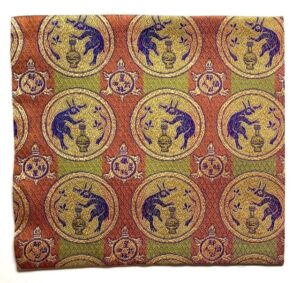
Ko-buku-sa, 古帛紗, old-cloth-gauze, modeled on the ancient Mandara at Tai-ma-dera, 当麻寺, Right-hemp-temple, in Katsura-gi, 葛城, Arrowroot-castle, Nara. The pattern includes an image of a hare making the Elixir of Life as depicted on the moon, together with a turtle the symbolically supports the earth. Often, it is said that the hare is making mochi in a mortar, usu, 臼, whereas a bottle-like container replaces the mortar. The vessel resembles similar containers depicted on the Ryōkai Mandara, that do contain kan-ro, 甘露, sweet-dew, an elixir of life. The ‘tree’ motif is believed to represent the katsura, 桂, katsura, cinnamon bark, that grows on the moon. Purveyed by Tatsu-mura, 龍村, Dragon-town.
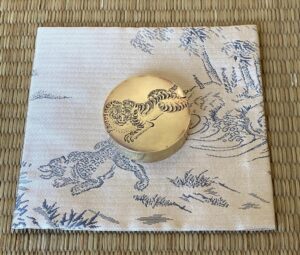
Ko-buku-sa, 古帛紗, old-cloth-gauze; shō-ha-ori, 紹紦織, help-‘ha’-weave, Chiku-ko-zu kire, 竹虎図,Bamboo-tiger-picture remnant, Toku-sai, 徳斎, Virtue-abstain. Design from paintings by Ka-no Ei-toku, 狩野永徳, War-field Ever-virtue, at Ju-kō-in, 聚光院, Assemble-Light-temple, sub-temple of Dai-toku-ji, 大徳寺, Great-virtue-temple, Kyōto.
Kō-gō, 香合, incense-gather; round, brass container with engraved design of a tora, 虎, tiger, marked kuni, 国, country; drawn from a design by Ka-no Ei-toku, 狩野永徳, War-field Ever-virtue; diam. 1.9 sun kane-jaku.The source of the design is detailed below.The tiger is often paired with the dragon: the tiger is a real animal and is In, 陰, negative, and the mythical, non-corporeal dragon is Yō, 陽, positive. It is interesting to note that the Chinese reading for the zodiac Tora, 寅, is In.
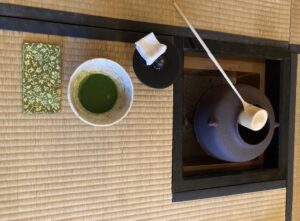
Arrangement of utensils with the ro, 炉, hearth. When preparing koi-cha, 濃茶, thick-tea, with a cha-wan, 茶碗, tea-bowl, that is not Raku-yaki, 楽焼, Pleasure-fired, the tei-shu, 亭主, house-master, offers a ko-buku-sa, 古帛紗, old-cloth-gauze, to be used by the guests. The folded kobukusa is kept in the front overlapping of the kimono, and is taken out with the right hand, placed on the left, and with the right hand is placed, still folded, near the chawan. The location of the chawan is near the kettle lid, with tangents between the center of the lid and the near rim of the chawan, and the right edge of the lid and the left rim of the chawan. Note that the direction of the cha-kin, 茶巾, tea-cloth, is parallel with the handle of the hi-shaku, 柄杓, handle-ladle.
Cha-kin, 茶巾, tea-cloth, made of asa, 麻, hemp, called Na-ra sarashi, 奈良晒, What-goodness bleach, after the old capital of Nara where it was made. Right: kobukusa with pattern of bo-tan Kara-kusa, 牡丹唐草, male-red Tang-grass, supplied by Tatsu-mura, 龍村, Dragon-town.
There are interesting comparisons between the ko-buku-sa, 古帛紗, old-cloth-gauze, and the cha-kin, 茶巾, tea-cloth. As pictured, both pieces are almost the same size. Each piece of fabric began as a rectangle approximately 1 x 2 units, and hemmed. Both of their widths are 5 sun kujira-jaku. The chakin length is 5 sun kujira-jaku – the kobukusa length is 4.3 sun kujira-jaku. The chakin has the selvage on two sides, with hems rolled in opposite directions on the other two sides. Both fabrics come in contact with the chawan. The chakin is wet, which manifests the negative principle of In, 陰, receptive, and the kobukusa is dry, which manifests the positive principle of Yō, 陽, penetrative. The chakin envelopes the chawan, In, whereas the kobukusa simply supports the chawan, Yō. The chakin is folded in thirds, Yō, the kobukusa is folded in halves, In.
The kobukusa is folded in half and stitched closed permanently, Yō, while the chakin is temporarily folded, In. The kobukusa is placed horizontally on the floor, which is In, and the chakin is used vertically to wipe the bowl, which is Yō.
When presented to the guest or guests, a kobukusa may or may not be included. In a simple presentations of koi-cha, 濃茶, thick-tea, in a chawan that is not Raku yaki, a folded kobukusa is placed alongside of the chawan when presented to the guest. The shō-kyaku, 正客, main-guest, moves to get the chawan and the kobukusa, and returns to his or her seat. The kobukusa is placed inside the heri away from the other guests. The chawan is placed inside the heri toward the ji-kyaku, 次客, next-guest. All of the guests bow in unison in the manner of gyō, 行, transitional, which is signify unity among the guests. The teishu does not bow at this moment.
The vessels containing water may refer to the four/eight quantities of water and tea mixed for eight bowls of usu-cha, 薄茶, thin-tea, drunk by the four Bosatsu, who have two bowls of usucha each.
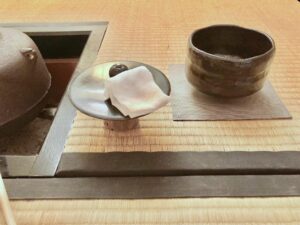
In the picture, with the ro, 炉, hearth, a kuro Raku cha-wan, 黒楽茶碗, black Pleasure tea-bowl, is placed on a ko-buku-sa, 古帛紗, old-cloth-gauze, ‘Rikyū kan-tō’, 利休 間道, Rikyū interval-way, check pattern. In the Tea presentation ‘Cha-wan kazari’, 茶碗荘, tea-bowl dignify, that features a very special teabowl, the chawan is placed on a kobukusa even if it is made of Raku-yaki, 楽焼, Pleasure-fired.
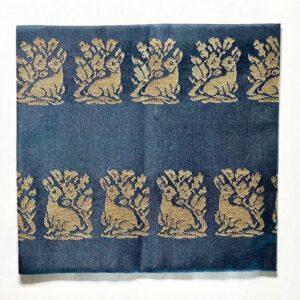
Yū-myō-sai, 又妙斎, Again-wondrous-abstain, XII Iemoto of Urasenke, was adopted, at the age of 20, from the Suminokura family, and married the daughter of Gen-gen-sai, 玄々斎, Mystery-mystery-abstain, XI Iemoto. Sumi-no-kura Ryo-i, 角倉了以, Corner’s -warehouse, was a wealthy merchant in the Azuchi-Momoyama and early Edo period. He traded widely overseas, and was involved in several important river projects in the Kyōto area.
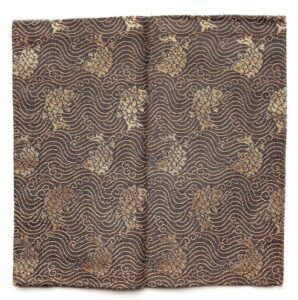
Ko-buku-sa, 古帛紗, old-cloth-gauze. Arai-sō kin-ran, 荒磯金襴, rough-shore gold brocade. The pattern is composed of koi, 鯉, carp, among serpentine waves, nami, 波. The koi is especially associated with the waterfall, taki, 滝, and Buddhism, the fish attempting to ascend the water is likened to the kundalini, and the maturation of the nervous system, and ultimately to enlightenment. The koi swimming up the waterfall and reaching pool above, is transformed into a tatsu, 龍,dragon, which is a symbol of enlightenment. The koi represents the developing spirit, which begins in the left big toe, rise to the backbone, waterfall, and enters the brain, cloud-like pool of satori, 悟り.
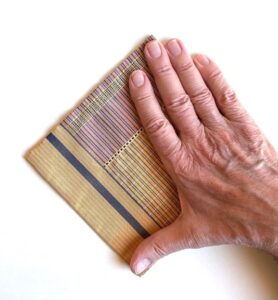
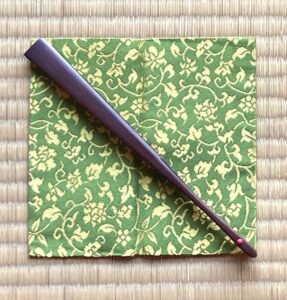
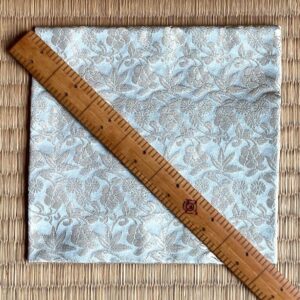
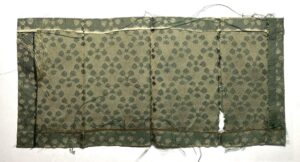
Heavily worn ko-buku-sa, 古帛紗, old-cloth-gauze, green silk fabric with pattern of ume no hana, 梅の花, prunus’s flower, called ‘Rikyū bai don-su’, 利休梅緞子, Rikyū prunus damask-of, from Tatsu-mura, 龍村, Dragon-town. The piece is opened flat showing varied hem treatment – note the manner of overlapping at the corners. Selvage at the left edge. The original measurements of the fully opened fabric are 9.5 x 5 sun kujira-jaku: the width of the hems is 5 bu kujira-jaku.
The measurement of 9.5 is found is a number of Tea utensils. The number 9.5 may have symbolic significance. In Japanese the number 9.5 can be read kyū-go, which can be written with the Kanji, kyū-go, 救護, salvation-safeguard, relief. Another example are the numbers kyū-go, 九五, nine-five; the number 9 is highest Yō/Yang single number, and 5 refers to the court rank of kun-shu, 君主, thou-master – so that the numbers 9 and 5 together infer the rank of ten-shi, 天子, heaven-son, the emperor. With the formal dai-su, 台子, support-of, and the naga-ita, 長板, long-board, the kazari hi-bashi, 飾り火箸, display fire-rods (L. 9.5 sun kane-jaku), are displayed in the shaku-tate, 杓立, ladle-stand, which is located on the area of the trigram Ken, 乾, Heaven of the I Ching/Eki-kyō, 易経, Change-sutra.
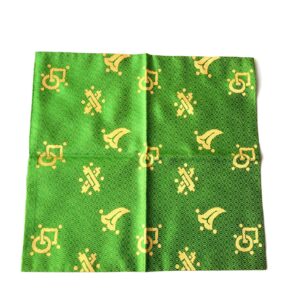
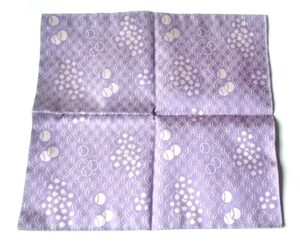
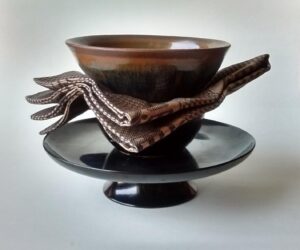
The use of a dashi buku-sa, 出帛紗, out cloth-gauze, is not the custom of Urasenke, a regular kobukusa is used in certain Tea presentations. Using a dashi bukusa more fully relates the folded fukusa to the lotus petals on an idealized support for a Buddhist deity.
The dashi bukusa is made of a piece of fabric approximate one by two shaku kujira-jaku, that is folded in half and hemmed on three sides. When used, the fukusa is folded in half two times to create four layers. Therefore, the folded, two-layer fukusa when folded twice creates eight layers. The folded fukusa has four corners, which multiplied by eight makes thirty-two layers of fabric. The folded dashi bukusa with its multiple corners could be likened to the many petals of the ren-dai, 蓮台, lotus-support, that supports image of Buddhist deities.
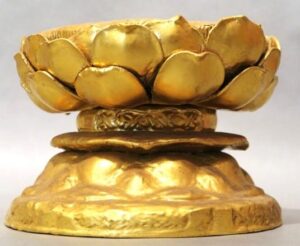
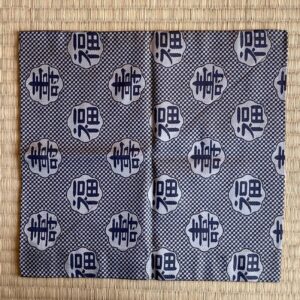
The pattern is secondary to the orientation of the fukusa when used, and opened in the tokonoma. This dashi bukusa may be the choice of the Yabu no uchi-ryū, 藪の内流, Thicket ’s within-manner, of Chanoyu, Kyōto. A dashi bukusa may be used to support a chawan presented to a guest. Some schools of Chanoyu use the dashi bukusa to hold and examine various objects.

Chi-tose-bon, 千歳盆, Thousand-years-tray, Tea presentation was created by Sen Ka-yo-ko,千嘉代子, Thousand Joy-generation-child for her husband, Tan-tan-sai, 淡々斎, Light-light-abstain, XIV Iemoto of Urasenke, on the occasion of his kan-reki, 還暦, return-calendar, 60th birthday. The tsubo-tsubo motif of water offering containers with the lids removed, is a variation of the tsubo-tsubo-mon, ツボツボ 紋, jar-jar-crest, created by Sō-tan, 宗旦, Sect-dawn, grandson of Rikyū, for the Sen families. The design was inspired by a water offering jar, den-bō, 田宝, earth-treasure, acquired by Sōtan at Fushi-mi Ina-ri Jin-ja, 伏見稲荷神社, Bow-see Rice plant-carry God-shrine.
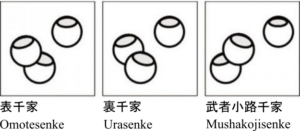
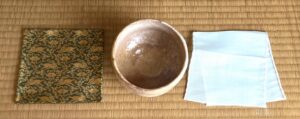
Ko-buku-sa, 古帛紗, old-cloth-gauze, green and gold silk thread shō-ha ori, 紹巴織, interlock-comma weave, with pattern of Kara-kusa Usagi, 唐草兎, Tang-grass Hare, Nishi-jin Ori, 西陣織, West-camp-weave, Kyōto. The fabric is silk, which manifest the element of Wood as it is plant transformed by an animal, silkworm. The kobukusa is square which is symbolic of Earth; it is horizontal, dry, and protects from the heat of the chawan. Structurally, it is permanently folded in half, and is temporarily folded once, and is turned.

Hagi cha-wan, 萩茶碗, bush clover tea-bowl, showing the ring foot, kō-dai, 高台, high-support. The relatively unglazed clay foot is exceedingly rough, which makes it imperative that when having a ko-buku-sa, 古帛紗, old-cloth-gauze, to support a chawan, one should always carefully lift the chawan off of the fabric to turn the bowl. Otherwise, the roughness of the clay might damage the fabric of the kobukusa. In practice, one should always lift and turn the chawan.
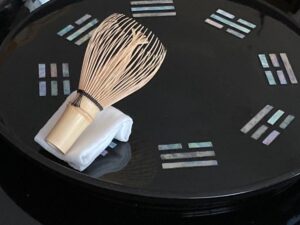
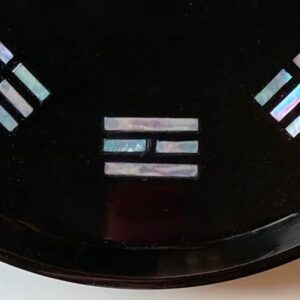
The cha-kin, 茶巾, tea-cloth, supporting the cha-sen, 茶筅, tea-whisk, is displayed on the hakke bon, 八卦盆, eight-divination sign tray, for a very formal Tea presentation. The chakin is placed at the front of the tray on the trigram Ri, 離, Detach, which is symbolic of Fire, and south. The chakin is folded to have an open part, In, 陰, is horizontal, In, and has a closed part, Yō, 陽, and a vertical part, Yō.
Cha-kin, 茶巾, tea-cloth; hemp (Wood), open fold – triangle is symbol of Fire, vertical, wet, hot, multiple foldings and re-foldings. When folded it is both In, 陰, negative, and Yō, 陽, positive. A guest uses a damp chakin to wipe bowl after drinking koicha. Hemp fibers are often processed in boiling of water, which may contain chemical compounds such as bleach.

Go-rin-tō, 五輪塔, Five-ring-tower; primary colors, which are near sacred to Buddhism, are manifested in the Gorintō: Earth, cube – yellow, Water, sphere – white, Fire, pyramid – red, Wind, bowl – black, and Void, teardrop – green/blue.
The Gorin are the Yō, 陽, positive principles, which have their counterparts in the Go-gyō, 五行, Five-transitions: Earth, Water, Fire, and Metal and Wood. The black bowl of the Gorintō has its earthly manifestation in the cha-wan, 茶碗, tea-bowl, especially the black Raku chawan. The physical element of Wood is manifest in the tea, and tea is like Kū, 空, the Void.
Depictions of the Gorintō, have various colors, depending on religious sects, however, the topmost ‘teardrop’ is most often a dark green, which corresponds with the green of ryoku-cha, 緑茶, green-tea, used to make ma-tcha, 抹茶, powdered-tea.
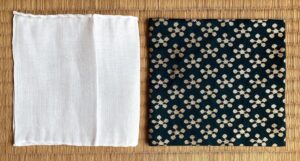
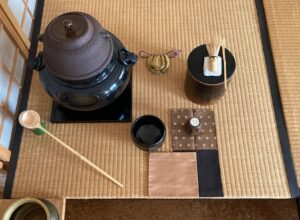
Fu-ro, 風炉, wind-hearth, arrangement of utensils for the Tea presentation, ‘Cha-ire Kazari’, 茶入荘, Tea-receptacle Dignify. The chaire was removed from the shifuku, and the shifuku was placed between the furo and the mizusashi. The kobukusa was placed near the mizusashi. The chaire was purified and placed on the kobukusa.
The kobukusa is located one width of a kobukusa (light brown) from the center of the tatami. The front edge of the displayed kobukusa is placed one length of a kobukusa (black) from the knee line of the teishu.
According to the I Ching/Ekikyō, 易経, Change-sutra, the shifuku is placed between the furo and the mizusashi in an area of the tatami that is identified with the trigram for Ken, 乾, Heaven, Emperor, northwest. The chaire on the kobukusa is placed in an area of the tatami that is identified with the trigram for Gon, 艮, Mountain, northeast, stop.
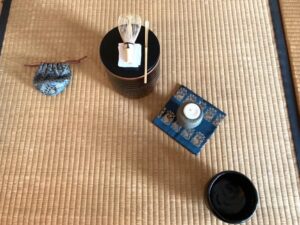
The arrangement of utensils when using the ro, 炉, hearth, for the Tea presentation, ‘Cha-ire Kazari’, 茶入荘, Tea-receptacle Dignify. The chaire was removed from its shifuku, and the shifuku was placed on the tatami between the mizusashi and the heri, 縁, edging, to the left. The kobukusa was placed close to the mizusashi near its usual location when using the ro. The chaire was purified and placed on the kobukusa.
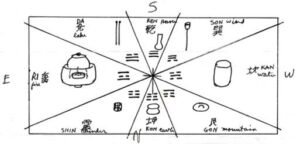
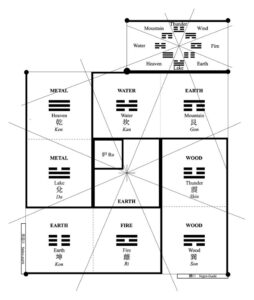
The dai-su, 台子, support-of, is placed in the center of the northwest corner han-jō, 半畳, half-mat. According to the I Ching/Ekikyō, 易経, change-sutra, the northwest is identified with the trigram, Ken, ☰, Heaven, dry, etc. and marked with the Kanji, 乾, which is read ken and inui. The daisu is therefore identified with Heaven. All of the Tea utensils are also identified with Heaven.
The chaire and chawan are placed in the area of the trigram Gon, 艮, Mountain. According to the Ekikyō, joining the trigrams for Mountain ☶ and Heaven ☰ creates a hexagram, ䷠, Ton, 遯, conceal, seclusion, flee, etc, or the hexagram, ䷙, Dai-chiku, 大畜, Large-beast. The depends on the placement of the trigrams. Another consideration is the trigrams identified with each utensil.

The width of a kai-chū ko-buku-sa, 懐中古帛紗, heart-middle old-cloth-gauze, is 4.1 sun kujira-jaku. The width of Kyō tatami is 2.5 sun kujira-jaku, divided by 6 is 4.1666 to infinity. The width of the kobukusa is approximately one/sixth the width of Kyō tatami. As this appears to be close to the width of the kaichū kobukusa, perhaps the true width of the kaichū kobukusa is 4.1666.
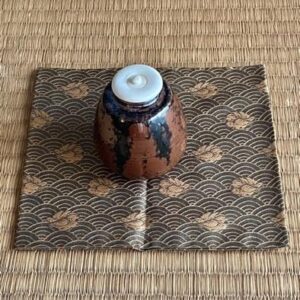
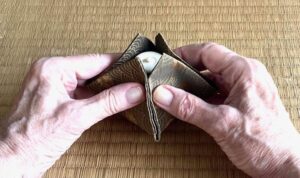
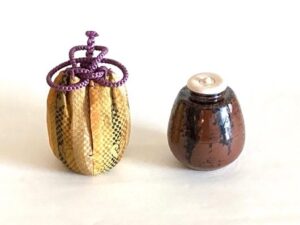
Left: ceramic cha-ire, 茶入, tea-receptacle, suitable for containing powdered tea for koi-cha, 濃茶, thick-tea, placed on a ko-buku-sa, 古帛紗, old-cloth-gauze. Center: kobukusa gathered up to nearly cover the entire chaire. Right: chaire with its shi-fuku, 仕覆, serve-cover. A shifuku is tailored to fit the chaire, rather than gathered together like a bag.
Chaire have been made in a wide range of sizes, so that only relatively small chaire can be covered completely by the standard kaichū kobukusa. In certain circumstances, the kobukusa is closely associated with the shi-fuku, 仕覆, serve-cover, of the chaire.
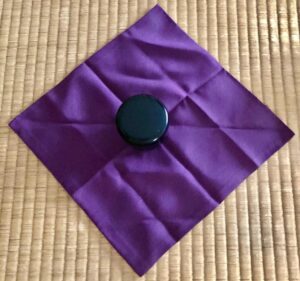
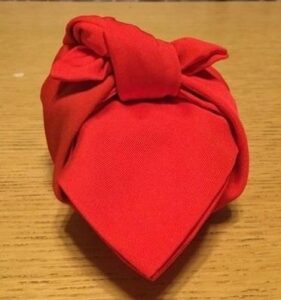
Rikyū-gata chū-natsume, 利休形中棗, Rikyū-style middle-jujube, placed on a purple silk fuku-sa, 帛紗, cloth-gauze, turned diagonally. Right: natsume wrapped in a red silk fukusa readied for a koi-cha, 濃茶, thick-tea, presentation called tsutsumi buku-sa, 包帛紗, wrapped cloth-gauze. A Rikyū-gata chū-natsume, is wrapped in the host’s fukusa: the fukusa is folded diagonally over the natsume.
Right: a natsume wrapped in a red silk fukusa readied for a presentation of tsutsumi buku-sa. This manner of wrapping an object is the same for wrapping objects in a square of u-kon mo-men, 鬱金木綿, dense-gold (turmeric) tree-cotton.
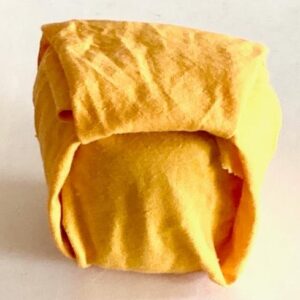
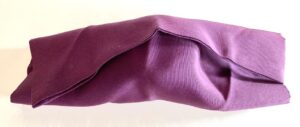
Left: natsume wrapped in a square of u-kon mo-men, 鬱金木綿, dense-gold (turmeric) tree-cotton, that is folded on the diagonal, in the manner in which it is kept in a storage box. The cloth is placed on the diagonal, the natsume is placed in the center, the front corner is folded over the top of the natsume, then the left corner, then the right corner, and the back corner is folded over the top of the natsume, and tucked under the corners previously folded over the top. Right: failure of wrapping the natsume with the fukusa folded rectilinearly.
There are fukusa that are too thick to tie in a knot for tsutsumi bukusa, which may cause one to use the fukusa to wrap the natsume in the manner of its storage ukon momen wrapper.
Wrapping an object with a square of fabric on the diagonal can be secure if one corner end is tucked under the other three, whereas the same square cannot hold together unless it is secured with the string or tape.
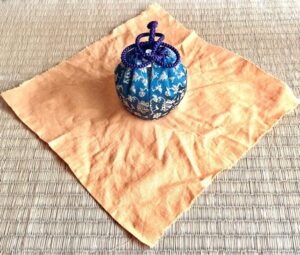
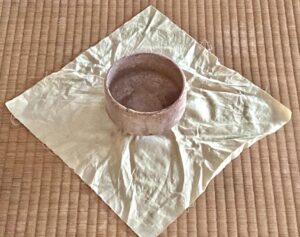
Hagi yaki cha-wan placed on a large square of u-kon mo-men, 鬱金木綿, dense-gold (turmeric)tree-cotton, that is used to wrap the bowl, and to put into a storage hako, 箱, box. The cotton square is wrapped diagonally: front corner, left corner, right corner, and back corner. The turmeric is used as a repellant against insects.
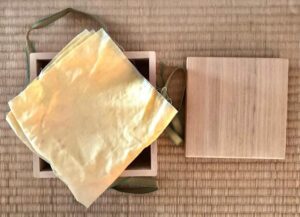
Folded u-kon mo-men, 鬱金木綿, dense-gold (turmeric) tree-cotton, wrapper for chawan, placed diagonally, as it would be when wrapped around a chawan. Having the cloth square diagonally in the box, creates ha-kkaku, 八角, eight corners, which is highly symbolic of Infinity in Space, extending outward in all directions.
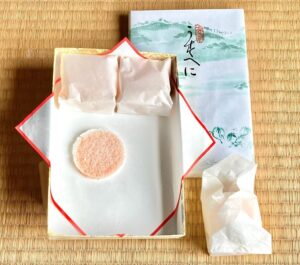
Hi-gashi, 干菓子, dry-sweet-of, two wafers sandwiching salty jam made of sweetened ume, 梅, prunus, named ‘Usu Beni’, 薄紅, Light Red, by Minamoto Ki-tchō-an, 源吉兆庵, Origin Lucky-omen-hut. The rectangular box has a square piece of paper aka-waku shiki-gami, 赤枠敷紙, red-frame spread-paper, placed diagonally in the box to create eight corners, which is much more auspicious than four corners. Three of the sweets are stacked, and wrapped in a similar diagonal manner.
For further study, see also: Eight-Ten: Fukusa, Kobuksa and Mandala Part 1, Kobukusa, Kobukusa Origins, Chakin and Lotus, Kobukusa Picture Gallery

